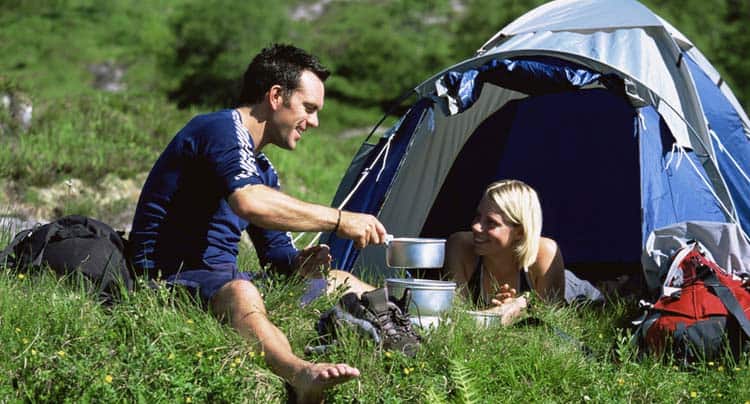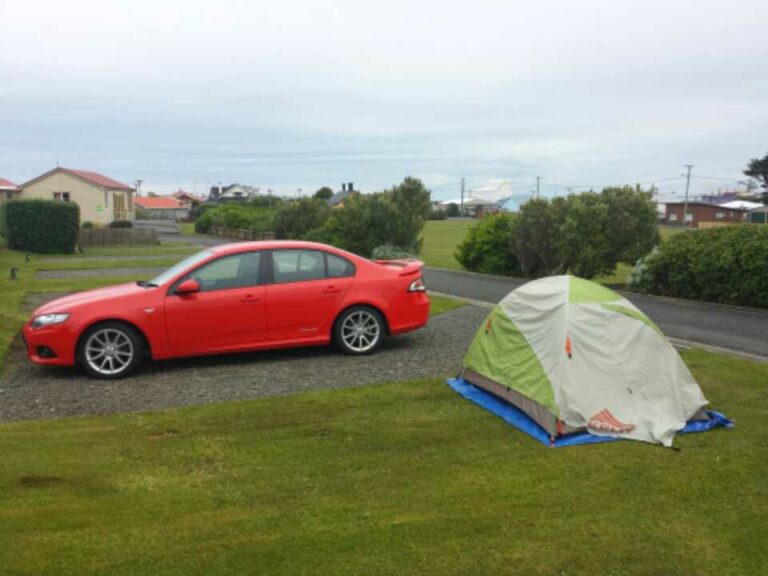A Quick Guide On How Much Dry Ice to Bring While Camping
Ever wondered about using dry ice for camping? Here’s a handy guide on how much you’ll need for your trip!

Generally speaking, you need to bring somewhere around 7-10lbs per day while you’re camping. However, the cooler you use and how much you insulate the ice can play key roles in whether you end up needing more or less.
Upon first glance, you might be thinking that 10lbs of dry ice every day seems like a lot. However, there are methods you can employ to keep the dry ice from running out so quickly. Read on and you’ll learn those methods and discover some key safety tips for using dry ice.
How Is Dry Ice Useful While Camping?
Not all campers realize just how helpful dry ice can be when you’re out in nature. It’s an easy thing to forget about with wet ice being so abundant! Some may even wonder how they’d even go about getting some dry ice.
The good news is, it’s available at a lot of the larger grocery stores you might go to while shopping for camping food to put in your cooler.
Here are just a few reasons you might want to consider using dry ice for your next camping trip:
- It’s colder. Dry ice is made at temperatures that are a great deal lower than wet ice. Consequently, it’ll be more effective at keeping your goods very cold. (Too cold in fact for drinks, unless you like exploding containers)
- It lasts longer. The increased coldness also means that dry ice won’t disappear as quickly as wet ice. This depends, however on how you pack your ice.
- Dry ice can help to keep you cool. If you want to keep yourself cool as well as your food, having some dry ice in your lounging area can be a great way to do it. Even just having the cooler filled with dry ice nearby can be a nice tiny breeze. Just know it won’t last very long if you use dry ice like this. (If you tend to camp in particularly hot areas, you may need some more ways to stay cool. For 13 tips on staying cool without electricity, have a peek at our article here.)
- It keeps mosquitoes away. Dry ice can attract mosquitoes. That means you can use it as bait to get keep them away from your skin. You can find more information on how to do that in our article on tips for using dry ice while camping. Take a look at it here! Essentially, you have to sacrifice some dry ice to make a mosquito trap–admittedly there are some more efficient ways to keep the bugs away. 🙂 Check out our comprehensive post on how to keep bugs away naturally.
How Much Dry Ice To Take Camping?
If you’re headed out into the woods and won’t have the ability to re-stock your ice, it makes sense that you’ll want to make sure you have enough to last the entire trip. I’ve taken a look at some typical estimates of what you might need for just a night to help determine how much you may need for a longer period of time.
Consider these numbers the next time you’re purchasing dry ice for a camping trip.
Note, the most important factor in how long your dry ice will last is how you pack your food around it. If you just have a few pounds of dry ice in a big empty cooler, then your dry ice will turn back into a gas rather quickly.
For A Night?
Overall, the amount of dry ice you’ll need on your trip can depend on a number of variables. It’s not always guaranteed that one specific amount will last as long as you need it to, so it’s always a good idea to have some funds on hand to purchase regular ice if you can.
Most of the resources I’ve looked through have recommended about 7-10lbs of dry ice for a 24 hour period. However, it is possible to get away with less if you have a smaller cooler or one that is specially designed with a lot of insulation and a powerful seal. If your food is packed tightly, you can get away with even as little as 4-5 pounds.
For A Week?
If you’re planning to take some dry ice camping for an entire week, it’s the perfect time to consider investing in a quality cooler if you don’t already have one. The coolers that are typically available at just about any store just aren’t going to be sufficient for making your dry ice last as long as possible.
Some campers might prefer to take the DIY route rather than purchasing a new cooler with better insulation. In our article on upgrading your cooler, you can find some handy tips on how to improve the cooler you already have. Check it out here!
On the other hand, a quality cooler can sometimes keep the dry ice from melting completely for a much longer period of time. Instead of actually going through 10lbs of dry ice a day, you can make 20-30lbs last for the entire week. It really is all about the insulation and sealing capability of the cooler, as well as how you pack your food.
Tips For Packing Dry Ice to Make It Last Longer
If you’re going to spend the time and money getting some dry ice, you’ll probably want to make sure it lasts as long as possible. After all, camping food needs to stay edible, and you might just be camping somewhere dry ice isn’t as easily available.
Follow these tips and you’ll have a much easier time keeping your dry ice solid for as long as you need it.
Layer It
Layering dry ice with another material can help it to last longer. It keeps the ice from mingling too closely with the food you’re trying to keep cold. All of your dry ice stays on one side of the divide while your food remains on the other. Often, cardboard or newspaper can be used for this purpose.
Another purpose this serves is keeping your food cold without freezing it completely. You’ll also be less likely to have to deal with chipping food items away from the ice. It will still be cold, but without the annoying factors that can come along with using ice for food storage purposes.
This is a crucial step if you are planning on trying to cool any drinks in the same cooler. You cannot have your drinks near your dry ice or your drinks will explode as they expand as they are frozen.
Freeze Food Beforehand
The colder your food is when you place it in the cooler, the easier it is for everything to stay cold without melting the ice. As an example, if you put refrigerator-cooled burgers into the cooler with your dry ice, the warmth of the meat can result in quicker ice evaporation.
On the other hand, if those burgers are already frozen, they won’t have as much of an effect on the dry ice. Naturally, this isn’t something you can do with all foods but it can be very helpful to at least freeze the ones you can before packing them up.
Keep The Cooler Sealed
Ensuring your cooler is properly sealed will help to keep any warm air from getting inside or cool air outside. Just like with food that isn’t frozen, warm air leaking into the cooler will result in faster melting of your dry ice.
Before you start packing, take a look at your cooler. Make sure it has plenty of insulation and that the rubber rings that ensure the lid seals are in good shape. Once you have everything packed, it’s best to limit the frequency with which the lid is opened. That often means storing more popular foods and drinks in a separate cooler.
Get Your Cooler Cool
Just like freezing what food you can before adding it to the cooler, it can help to get the cooler itself colder before getting it filled up with ice and food. Basically, this idea just gives you a head start before the ice starts melting.
If you have something like an empty freezer chest that your cooler fits in, you can try putting it in there for a few hours. Otherwise, this can be a bit trickier to accomplish. At the very least, put it in a cool spot for a while so at least the cooler isn’t warm when you start loading it up.
Avoid Warm Spots
Whether you’re using dry ice or regular ice, keeping your cooler out of the sunlight is vital for helping it to stay as cold as possible. Those who camp with trailers or motorhomes can use the shade of their vehicle to protect the cooler from sunlight.
Otherwise, look around for areas that stay in the shade as much as possible. In areas with fewer trees, that might mean you have to move the cooler at some point during the day. It may also be tempting to store the cooler in your tent, but it’s best not to. The cooler might be protected from sunlight inside the tent, but it often won’t be protected from excess heat. Also–dry ice is carbon dioxide, and becomes dangerous in enclosed spaces
Use Newspaper
Insulation is a huge factor in how quickly your dry ice melts. That includes both the insulation in the cooler itself as well as the insulation on the inside. There are a number of great coolers out there, like the Yeti Tundra, which strive to provide as much insulation as possible.
In addition to choosing a quality cooler, you can also add insulation around your ice in a much less expensive way. By carefully wrapping up your dry ice using some newspaper, you can keep it from melting quite so quickly. Wrap up larger chunks like you’re wrapping a present, and simply wad up bits of newspaper to add into coolers using smaller pieces of dry ice.
Supplement it
If you want to be extra certain your cooler will stay cold for as long as possible, it doesn’t hurt to add some regular ice into the mix. For example, some campers like to lay down their dry ice and cover it with a piece of cardboard. On top of that cardboard, you can place your food and drinks, filling in the gaps with added regular ice.
With the help of the wet ice, the dry ice won’t need to do as much work to keep your food cold. It’s really a great way to keep everything at the right temperature without having to stuff your cooler with dry ice only, which can sometimes be tricky to get food out of!
Get The Ice In Blocks
If you have the choice between smaller pieces of dried ice and larger blocks, go for the blocks. The small pieces might fill in more gaps, but they will also melt more quickly. Meanwhile, larger dry ice blocks will last longer. They will also make it easier to create layers to improve the insulation in your cooler.
Safety Tips For Using Dry Ice
There’s more to keep in mind while using dry ice than how to make it last longer. Handling and using dry ice requires more of a focus on safety. To help you to stay safe and get the most from your dry ice, I’ve compiled a couple of important tips below. Take a look!
Don’t Touch
Touching regular ice can get uncomfortable after just a short period of time. If it’s in contact with your skin for too long, it can even result in issues like frostbite. However, typically touching it for a short amount of time won’t result in any real damage.
However, because dry ice is so much colder than the ice we often use, damage to your skin can happen much more quickly. According to an article by Washington State University, dry ice can reach temperatures as low as -109. Because of that, it’s a good idea to wear gloves and any other protective gear you may need in order to handle it safely. In a pinch you can just make sure that newspaper layer is never removed.
Dispose Of The Dry Ice Safely
Dry ice can be a bit more tricky to dispose of than regular ice. Because normal ice is just frozen water, there really aren’t any problems with letting it melt in the drain, on the ground outside or wherever else you might put water when you want to get rid of it.
Unlike wet ice, dry ice is made using carbon dioxide. That can mean a couple of things when it comes to disposal. The first is that you want to make sure it’s in an open environment, as evaporating dry ice can create a lot of gas. Secondly, you shouldn’t place dry ice in the sink. Because it’s so much colder than wet ice, it can cause issues in your plumbing. It’s really not worth having to get pipes replaced!
Instead, it’s a good idea to let it sit outside until the dry ice has evaporated all the way. It’s much safer out there than it will be inside. Once it’s gone, you can clean and store your cooler until the next trip.
Don’t Use in a Tent
Since dry ice is carbon dioxide, it is hazardous to breathe. It’s not safe to use in your tent to try and keep your tent cool because it will replace the air in your tent.
Be Careful In Your Car
It turns out your car is also an enclosed space that is hazardous for dry ice. You must have your dry ice in a sealed container (i.e. your cooler), and that the seal is good. If you don’t have a window cracked or if you are using the re-circulation feature in your car, then you may be making your car into a dangerous carbon dioxide pod.
Crack a window, turn off re-circulation when you’re transporting dry ice.



